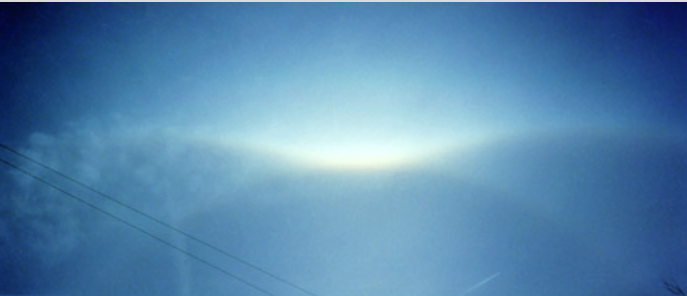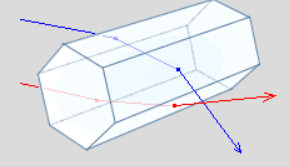Tangent Arcs
Tangent Arcs: Exploring the Phenomenon
Tangent arcs, a fascinating atmospheric optics phenomenon, occur when cirrus clouds contain columnar ice crystals drifting with their long axes almost horizontal. These crystals, known as "singly oriented columns," exhibit a unique orientation constraint. While their long axes must be horizontal, they can freely rotate around both their long and vertical axes.
When conditions are favorable, tangent arcs manifest as vibrant, yet delicate, arcs that extend outward from the point where they touch the 22º halo directly above and below the sun. The colors of these arcs are most pronounced when observed directly, although photographs often struggle to capture their true beauty.
The shape of the upper and lower tangent arcs undergo significant changes throughout the day, particularly between sunrise and noon. Observing their variations in an animation can provide a mesmerizing insight into their dynamic nature.
As the sun ascends above 29º, the upper and lower tangent arcs merge, forming a single halo that encircles the sun entirely. This halo is known as the "circumscribed halo," offering a captivating spectacle for skywatchers.
To comprehend the formation of tangent arcs, it is crucial to understand the behavior of light as it interacts with these unique ice crystals. The rays of tangent arcs enter a side face of the crystal and exit through another face inclined at an angle of 60º to the first. Similar to the rays forming the 22º halo, there is a minimum deviation angle of 22º after two refractions. However, larger deviations also occur, resulting in the formation of tangent arc "wings."
Red light, being refracted less strongly than other colors, occupies the halo edge closest to the sun. This phenomenon gives rise to the characteristic reddish hue observed in this type of halo. While photographs may struggle to capture the full range of colors, direct observation allows for a more immersive experience of the halo's vibrant display.
It is worth noting that the crystal faces through which the rays of tangent arcs pass are the same as those encountered in the formation of the 22º halo and sundogs. The distinguishing factor among these halos lies in the orientation of the crystals involved. Tangent arcs arise from the presence of singly oriented columns, whereas other halos have different crystal orientations.
In conclusion, tangent arcs provide a captivating spectacle in the realm of atmospheric optics. These arcs, formed by the interaction of light with horizontally oriented columnar ice crystals, exhibit a range of colors and shapes throughout the day. While photographs may struggle to fully capture their beauty, direct observation allows for a more immersive experience. Understanding the unique crystal orientation and the principles of light refraction involved in their formation adds to the fascination of studying these atmospheric phenomena.
Tangent Arc

Intense upper tangent arc. The gull winged arc always touches the 22º halo at a point directly above the sun. Its wings open and then droop as the sun climbs. Here it was 22º high. Imaged by Malcolm Garland at Sheffield, England on 9th February '01. Malcolm Garland, reproduced with permission

Singly oriented column crystal with upper and lower Tangent Arc rays. The rays enter a prism side face and leave through another inclined 60º to the first.
The best tangent arcs wing outwards from where they touch the 22º halo directly above and below the sun. Their colours are bright yet delicate. Red is sunward. On less favourable days they can be just local brightenings of the 22º halo.
The upper and lower arcs change shape considerably between sunrise and noon. Look at their variations in the animation.
When the sun climbs above 29º both arcs join into a single halo wrapped right around the sun - the "circumscribed halo".
Tangent arcs form when cirrus clouds have well developed columnar ice crystals drifting with their long axes almost horizontal. These are called "singly oriented columns" because having their long axes horizontal is their only orientation constraint. They can take up any rotational position around their long axis and a vertical axis. This crystal orientation is a common one and produces a number of different halos.
The rays of tangent arcs enter a side face and leave directly through another inclined 60º to the first. As in the rays forming the 22º halo, a deflection of 22º after the two refractions is the angle of minimum deviation but larger ray deviations occur as well. Thus the tangent arcs touch the 22º halo but rays deviated through larger angles (including skew rays) form its 'wings'.
Red light is refracted less strongly than other colours and so the halo edge closest to the sun is red. The halo's colours are much more apparent when seen directly, photographs rarely do them justice.
Tangent arc rays pass through the same crystal faces as those of the 22º halo and sundogs. The essential difference in the formation of the three halos is the orientation of their crystals.
Note: this article has been automatically converted from the old site and may not appear as intended. You can find the original article here.
Reference Atmospheric Optics
If you use any of the definitions, information, or data presented on Atmospheric Optics, please copy the link or reference below to properly credit us as the reference source. Thank you!
-
<a href="https://atoptics.co.uk/blog/tangent-arcs/">Tangent Arcs</a>
-
"Tangent Arcs". Atmospheric Optics. Accessed on April 27, 2024. https://atoptics.co.uk/blog/tangent-arcs/.
-
"Tangent Arcs". Atmospheric Optics, https://atoptics.co.uk/blog/tangent-arcs/. Accessed 27 April, 2024
-
Tangent Arcs. Atmospheric Optics. Retrieved from https://atoptics.co.uk/blog/tangent-arcs/.